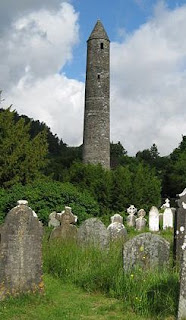 |
| St. Kevin's Church |
Just south of Dublin in the Wicklow Mountains is Glendalough, literally Glen of Two Lakes. It was here that Kevin (Coemgen in Gaelic) started a hermitage in the sixth century. Kevin was a monk at Kilnamanagh, now the neighborhood of Tallaght in Dublin, but then decided to become a hermit.
 |
| Glendalough - Glen of the Two Lakes |
Kevin tried sneaking off to be a alone again, but the monks dragged him back, begging him to lead them. He gave up and served as their abbot until his death of extreme old age. Legend says he lived to be 120.
Glendalough continued to grow in influence, becoming one of the major places of pilgrimage. It also had a school teaching aspiring monks and nobility alike. Glendalough was just one of many monasteries with schools throughout Dark Age Ireland. The Emerald Isle became famous throughout Europe for it’s learning. Charlemagne, when trying to establish a new Holy Roman Empire, made sure to invite Irish scholars to his court.
Glendalough however soon became overshadowed by a growing Dublin. In 1398 an English army partially destroyed Glendalough and it became a backwater. In a way that was a blessing, for it put the valley out of the notice of the far more destructive Cromwell and William of Orange.
 |
| Round Tower |
There are several churches in various degrees of ruin here, but the best preserved and probably oldest is St. Kevin’s “Kitchen.” It’s really a chapel. It was so well built that last century it was “restored” by sweeping out and adding wooden pews for worship.
Further up the valley on the banks of the Upper Lake is St. Kevin’s Bed, the cave he originally lived in. It was worth the hike to see it. The scenery is so lovely the trek was most pleasant in itself. St. Laurence O'Toole (Lorcán Ua Tuathail), the abbot of Glendalough in the 12th century, used to sleep here, too. He was later made Archbishop of Dublin, then a largely Viking town, who approved his appointment, making him the first Irish Bishop of Dublin. It was probably not very respectful of me, but I couldn’t fight the urge to lie down in the spot I assumed the two saints had laid. It filled me with wonder, but mostly with pain from that stone in my back. Not at all comfortable. I do hope the poor chaps at least had some straw.
 |
| St. Kevin's Bed Cave |
Kevin will not be made an official saint until 1903. Back in 618 when he died, canonizing wasn’t a common practice yet. He will not only be considered a saint by the Roman Catholic Church, but by the Orthodox Church and the Anglican Church as well. Of course he has always been considered a saint here in Ireland even while he was still alive.
I hung about the Glen of the Two Lakes until I was forced to catch the last train back to Dublin. I must say spending your entire life in this beautiful valley would hardly be a hardship. Kevin picked well.
Rick Steves visits Glendalough
(as well as Powerscourt Estate I saw last week)




No comments:
Post a Comment
Due to bots sticking ads into the comments I am now forced to moderate. Differing opinions are welcomed. This is history, which is the surviving written record, which may or may not be accurate. I will even allow comments pushing other books or websites as long as they are relevant.